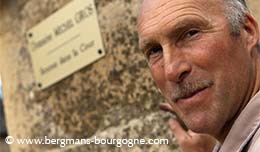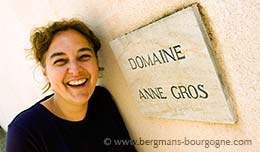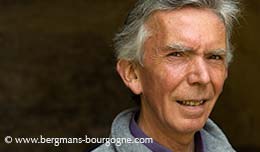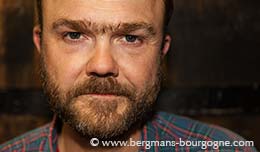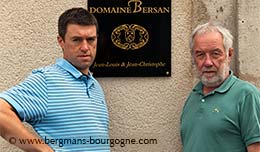
omaine Sébastien Dampt, a young domaine in Milly, is one of only two places where you can taste the Chablis premier cru Les Beugnons.
– The soil is very chalky, a mix of clay, explains Sébastien Dampt. The wines have a reputation for being more mineral and concentrated.
Milly is just outside Chablis. Sébastien Dampt has his own domaine set up here, under the same roof as his father and his brother. Three domaines – Domaine Sébastien Dampt, Domaine Daniel Dampt and Domaine Vincent Dampt – covering a total of 35 hectares.
 Sébastien Dampt set up his domaine in 2007 and started bottling the year after. He works six hectares, producing five different wines – Petit Chablis and Chablis, as well as three premier crus – Vaillons, Côte de Léchet and Les Beugnons.
Sébastien Dampt set up his domaine in 2007 and started bottling the year after. He works six hectares, producing five different wines – Petit Chablis and Chablis, as well as three premier crus – Vaillons, Côte de Léchet and Les Beugnons.
For Les Beugnons the first vintage is 2013. Les Beugnons is a sub-climat of Vaillons. All the principal premier crus in Chablis are made up of a number of sub-climats. If all your vines for a certain wine are within the same sub-climat you have the choice of either putting the name of the sub-climat (Les Beugnons) or the name of the principal premier cru (Vaillons) on the label. If your vines are in different sub-climats within the same premier cru your only choice is the name of the latter.
– Les Beugnons is located at the extreme south of Les Vaillons, says Sébastien Dampt. It is facing almost straight south, while the rest of Vaillons is facing east and even north, as is the case with Les Lys. If you look at some of the other sub-climats in Vaillons, Sécher is drier, while Les Lys produces a wine with more freshness
 – The exposition of Les Beugnons is nearly the same as for Les Butteaux in the neighbouring valley. Butteaux is a sub-climat in the extreme south of Montmains.
– The exposition of Les Beugnons is nearly the same as for Les Butteaux in the neighbouring valley. Butteaux is a sub-climat in the extreme south of Montmains.
– The monks of the Pontigny abbey started to use the word "climat" for Les Beugnons in 1572, according to a document found by Jean-Paul Droin in the archives of Pontigny. So it seems to be one of the oldest climats of Burgundy.
The other cellar where you can taste Les Beugnons is at Château Long Depaquit.
Sébastien Dampt can trace his winemaking family far back. It originates from the Côte d’Or and the domaine dates back some 150 years.
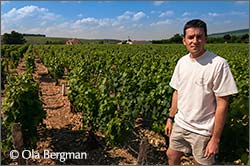 – My father Daniel is the son-in-law of Jean Defaix, my grand-father, he says. So our vineyards come from him.
– My father Daniel is the son-in-law of Jean Defaix, my grand-father, he says. So our vineyards come from him.
When Sébastien Dampt started out it was with a very modest production. Just 50 hectolitres of Chablis. That’s about 6666 bottles. Since then his domaine has grown. Today it covers six hectares – four hectares of Chablis vines, 1.70 hectare of Chablis premier cru and 0.30 hectare of Petit Chablis.
– I want to keep the same style of vinification as my father and grandfather. I try to let the expression of the terroir speak. Thanks to the stainless steel tanks we have a system to produce very mineral wines. The vinification process is basically the same for all wines. So the difference you taste is the difference between the parcels.
 – For Les Beugnons I have bought an egg-shaped concrete tank. I’m the first one to that in our family. With concrete you get micro-oxidation. It’s the same as with barrels, but you don’t get the taste of wood. It brings more fat to the wine.
– For Les Beugnons I have bought an egg-shaped concrete tank. I’m the first one to that in our family. With concrete you get micro-oxidation. It’s the same as with barrels, but you don’t get the taste of wood. It brings more fat to the wine.
The Chablis premier cru Vaillons produced by Sébastien Dampt comes from a parcel of 60-year old vines, often with millerande grapes. The yield is low, about 45 hl/ha. The soil is very chalky on this east-facing slope that sees the sun from morning to evening.
– Côte de Léchet is on the opposite side of Milly, but it is quite similar to Vaillons, says Sébastien Dampt. It is a very good example of the minerality of Chablis. The name is less known than Vaillons, but most of the time when people taste the two they tend to prefer Côte de Léchet. It is also a very good wine to keep. My grandfather would always keep bottles of Côte de Léchet, because he knew they would age well.
– The difference in soil between Côte de Léchet and Vaillons is not a big one. The soil in Côte de Léchet is a bit finer and a bit more chalky.
 Sébastien Dampt’s four hectares of Chablis vines are spread out over several parcels. Half of them come from a large parcel covering two hectares just below Vaillons.
Sébastien Dampt’s four hectares of Chablis vines are spread out over several parcels. Half of them come from a large parcel covering two hectares just below Vaillons.
– The vines are 40 years old. There is a small road there, so it is only three metres separating the village Chablis vines from the premier cru. Just below this parcel you have the town of Chablis. I blend these grapes with grapes from other parcels with younger vines. There is Petit Léchet just below Côte de Léchet and Champlain just below Les Lys.
In addition to his own wines Sébastien Dampt also runs a small négociant business together with his three years older brother Vincent. Even if land prices in Chablis haven’t reached the levels of the Côte d’Or it is still very expensive to buy vineyards here. By buying grapes the Dampt brothers are able to add some grand cru – Les Clos, Bougros and Valmur – to their portfolio.
– The production is small, says Sébastien Dampt. We use barrels for Les Clos, but the youngest are two years old. We use them for six years, then we buy ”new” ones. It is difficult to buy second hand barrels, because it is difficult to know how they have been handled, if the quality is OK.
– I buy the barels from Domaine Michel Niellon in Chassagne-Montrachet. I know the grandson and I know I always get good barrels from there.
© 2013 Ola Bergman










